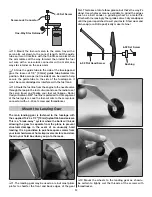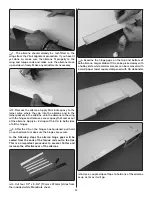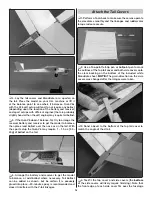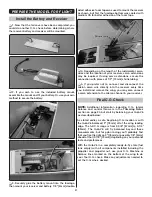
35
always must be as effi cient as possible. Pulling too hard
on the elevator causes too much drag resulting in the loss
of too much speed by the time you complete the turn. You
may cover less distance, but you’ll dramatically reduce
your airspeed entering the following straight. Conversely,
making too soft and wide a turn will take too much time
by covering too much distance. Exit speed will be higher,
but not enough to offset the distance fl own. The optimum
turn is somewhere between the two. Many of the fastest
racers set their elevator throws so that they pull full
elevator defl ection around P1 (pylon 1) and around P2-P3.
If you have your rate set correctly for the 3-pole course,
you should be able to bank into pylon 2 and smoothly pull
elevator to full defl ection and end up just clearing pylon 3.
ROLL STABILITY IN TURNS:
The next step is to dial
in the
way
the plane turns. What we’re after is a plane
that, when banked 90°, it exits the turn still at a 90° bank
without climbing or descending. We want the plane to fl y
as though the weight is equal on both wing tips. If one
side is heavier than the other, the plane will roll toward the
heavy side when you pull elevator. Even though the plane
was laterally balanced on the workbench, sometimes
other factors contribute to this unwanted roll, but you can
still correct it by weighting the tip that reacts as though it
is lighter. To check for this condition, fl y the plane away
from yourself so you can bank it 90°. Execute a full elevator
180° turn toward yourself simulating a pylon 1 turn. If the
Quik-V6 rolls left or right, it will also climb or dive. If it rolls
out
of the turn and climbs, add weight to the lower wing.
If the plane descends and rolls
into
the turn, add weight to
the high wing. This will dramatically help with consistency
of your laps and your ability to control the altitude as you
navigate the course.
YAW STABILITY IN TURNS:
Next is the rudder. Of
course, same as with aileron and elevator, the plane must
be trimmed for level fl ight without yawing left or right.
Now, trim the rudder so that the plane is easy to hold a
constant altitude through the turns and is comfortable
holding a partial bank angle in the straights. Don’t add too
much rudder and cause it to fl y tail low when banked. You
want just enough to get the plane comfortable without
descending or ascending as you fl y the course.
If, when pulling elevator in a turn you do not observe the
plane rolling, yet it still changes altitude exiting the turn
higher or lower than the entrance, one ruddervator may
be travelling farther than the other. For example, if the
left
ruddervator defl ects slightly more than the right, this
effectively adds
right
rudder as you pull. Of course, the
opposite is true if the
right
ruddervator defl ects more. This
can be subtle to recognize, but can really make a difference
in the way the plane fl ies. Use your End Point adjustments
to add or remove a few percent of throw from the side you
think is travelling farther. 3% to 5% can make a noticeable
difference. When this adjustment is needed, it is most
noticeable at the turn exit. Do not confuse this with the tip
weight adjustments—they are correcting different problems.
TRACK TOWARD PYLON 1 (C.G.):
Next, we’ll dial in
how the plane fl ies in the straightaways. This depends on
what course you’ll be fl ying (2-or 3-pole) and the distance.
In AMA Class 424 and Class 426 we mostly use the 475’
3-pole course, but sometimes these classes are fl own
at the same event as Quarter Midget Class 422 on the
longer 608ft course. The two-pole course distances used
by some clubs also varies. On the longer courses, you’ll
obviously spend more time in the straights, making it more
worthwhile to roll the wings closer to level. On the shorter,
475’ 3-pole course, you’ll fi nd that the faster way around
will be to
not
roll the wings closer to level in the straights.
Then, you would roll out to a bank angle of approximately
45 to 80° in the straight. When viewed from above, your
path around the three pole course will resemble the shape
of an egg with the course in the straightaways being a
gentle curve connecting the tighter turns on each end. If
done correctly, this will reduce the time that you spend in
each turn at high elevator defl ection and the additional
drag that comes with it.
To understand the adjustment required, you have to
understand the effect of elevator trim on the trajectory
the plane takes while banked. First, a plane with a
farther forward C.G. will require more up elevator trim
to fl y straight-and-level than a plane with a farther aft
C.G. And maybe not even much—just a couple of clicks.
When banked to say, a 45° angle, the slightly nose-heavy
situation with the up elevator trim will cause the plane
to pitch toward the top of the fuselage, or drift slightly
toward the pylon. Conversely, a plane with a farther aft
C.G. (requiring less up trim) will cause the plane to make
a less gradual turn toward the direction it is banked.
With this in mind, fl y your Quik-V6 on the course. When
you exit a turn, roll out to a 45 to 60° bank angle as you
enter the straight and ease off the elevator. If the plane
drifts toward pylon one before you want it to, move the
C.G. aft a little, re-trim for level fl ight, then put it back on
the course. It should now drift toward the pylon less than
before. If it goes
too
straight for your preference, move
the C.G. forward. Re-trim the Quik-V6, then put it back
out on the course. It will now drift slightly more in the
straights. The thing to remember is you may want the
C.G. in a different location for a longer course with longer
straightaways. Usually, you will want the C.G. slightly aft
for a longer course to curve less in the straights.
Keep in mind that, while you’re working through these
steps, you may fi nd one adjustment has a small effect
on the other. That’s okay. Just work with the different
adjustments discussed to fi nd a balance where all of
these factors work well together. Once completed, you’ll
have a Quik-V6 that will be easier to fl y faster and more
consistently than one where you have to work so hard.
These techniques apply to any pylon racing plane and
much of it to any plane you fl y.
You can continue to learn more by seeking out races and
racers in your area and get to know them. The NMPRA
is a great organization fi lled with members who enjoy
helping the new guy develop their skills and helping them
enjoy the thrill of pylon racing.
You can learn more about pylon racing and the NMPRA
(National Miniature Pylon Racing Association) at
www.
nmpra.org.
The complete rulebook is available at
www.
modelaircraft.org
.


































